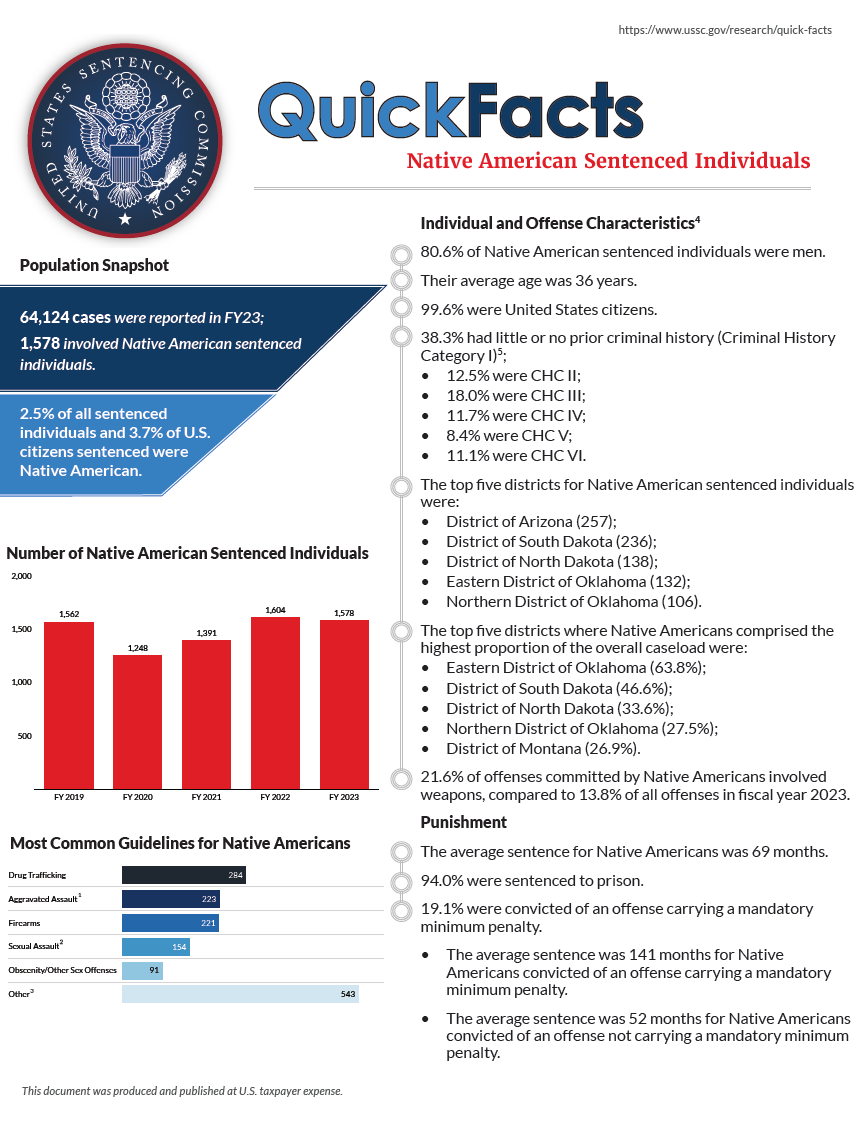Of the 61,678 cases reported to the Commission in fiscal year 2024, 1,727 involved Native American sentenced individuals. Native Americans accounted for 2.8% of all federally sentenced individuals and 4.3% of federally sentenced U.S. citizens in FY 2024.
Click the cover for the PDF handout or learn more below.
Individual and Offense Characteristics
- 80.5% of Native American sentenced individuals were men.
- Their average age was 37 years.
- 99.9% were United States citizens.
- 41.4% had little or no prior criminal history (Criminal History Category I):5
- 16.6% were CHC II;
- 15.5% were CHC III;
- 8.6% were CHC IV;
- 7.0% were CHC V;
- 10.9% were CHC VI.
- The top five districts for Native American sentenced individuals were:
- District of South Dakota (321);
- District of Arizona (213);
- Eastern District of Oklahoma (199);
- Northern District of Oklahoma (180);
- District of Montana (128).
- The top five districts where Native Americans comprised the highest proportion of the overall caseload were:
- Eastern District of Oklahoma (67.0%);
- District of South Dakota (56.6%);
- District of Montana (35.2%);
- Northern District of Oklahoma (28.9%);
- District of North Dakota (28.2%).
- 22.2% of offenses committed by Native Americans involved weapons, compared to 13.8% of all offenses in fiscal year 2024.
Punishment
- The average sentence for Native Americans was 72 months.
- 94.8% were sentenced to prison.
- 18.3% were convicted of an offense carrying a mandatory minimum penalty.
- The average sentence was 159 months for Native Americans convicted of an offense carrying a mandatory minimum penalty.
- The average sentence was 52 months for Native Americans convicted of an offense not carrying a mandatory minimum penalty.
Sentences Relative to the Guideline Range
- 62.6% of sentences for Native Americans were under the Guidelines Manual.
- 42.8% were within the guideline range.
- 7.1% were substantial assistance departures.
- The average sentence reduction was 58.5%.
- The average sentence reduction was 58.5%.
- 3.5% received an Early Disposition Program (EDP) departure.6
- The average sentence reduction was 54.9%.
- The average sentence reduction was 54.9%.
- 5.8% were some other downward departure.
- The average sentence reduction was 39.0%.
- The average sentence reduction was 39.0%.
- 42.8% were within the guideline range.
- 37.4% of sentences for Native Americans were variances.
- 32.2% were downward variances.
- The average sentence reduction was 43.3%.
- The average sentence reduction was 43.3%.
- 5.2% were upward variances.
- The average sentence increase was 63.9%.
- 32.2% were downward variances.
- The average guideline minimum and average sentence imposed have increased over the past five years.
- The average guideline minimum increased from 63 months in fiscal year 2020 to 79 months in fiscal year 2024.
- The average sentence imposed increased from 53 months in fiscal year 2020 to 72 months in fiscal year 2024.
- The average guideline minimum increased from 63 months in fiscal year 2020 to 79 months in fiscal year 2024.
1 Cases with incomplete sentencing information were excluded from the analysis.
2 Aggravated assault includes cases where the court applied §2A2.2 as the primary sentencing guideline.
3 Sexual assault includes cases where the court applied §§2A3.1, 2A3.2, 2A3.3, or 2A3.4 as the primary sentencing guideline.
4 “Other” guidelines include Manslaughter (85), Murder (79), Immigration (73), and Fraud (61). No other guideline had a value greater than 50.
5 Tribal offenses are not counted in determining the criminal history score under the sentencing guidelines. See §4A1.2(i).
6 Early Disposition Program” (or EDP) departures are departures where the government sought a sentence below the guideline range because the defendant participated in the government’s Early Disposition Program, through which cases are resolved in an expedited manner. See USSG §5K3.1.
SOURCE: United States Sentencing Commission, FY 2020 through FY 2024 Datafiles, USSCFY20-USSCFY24.

